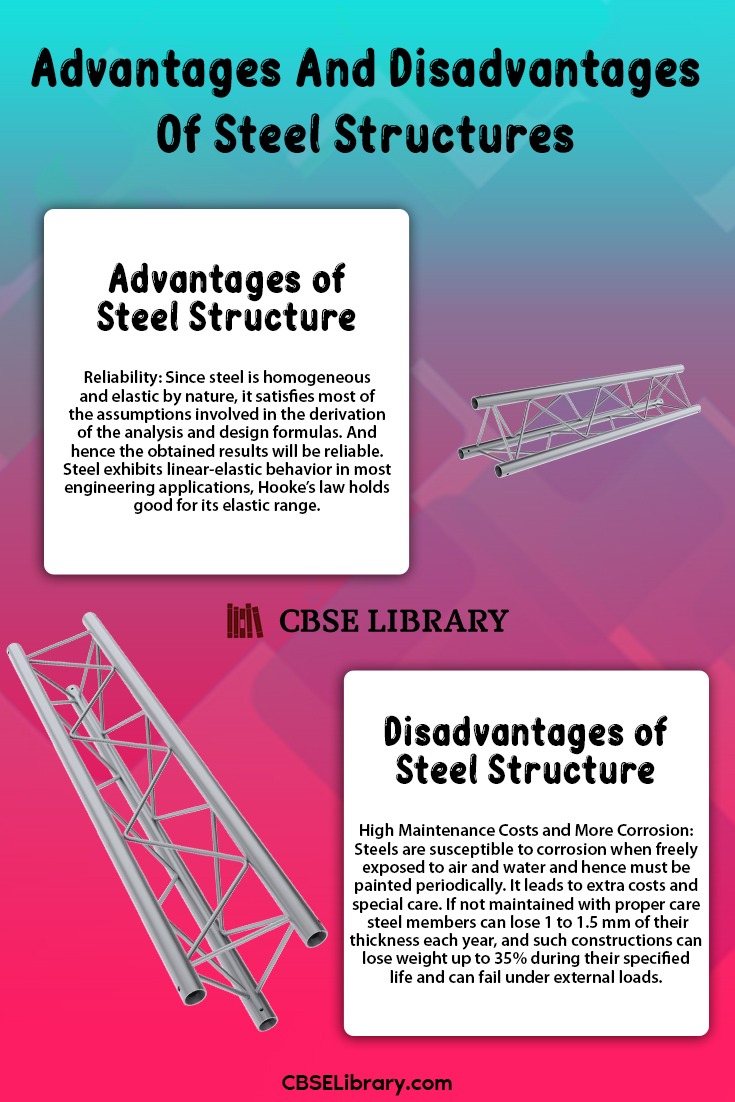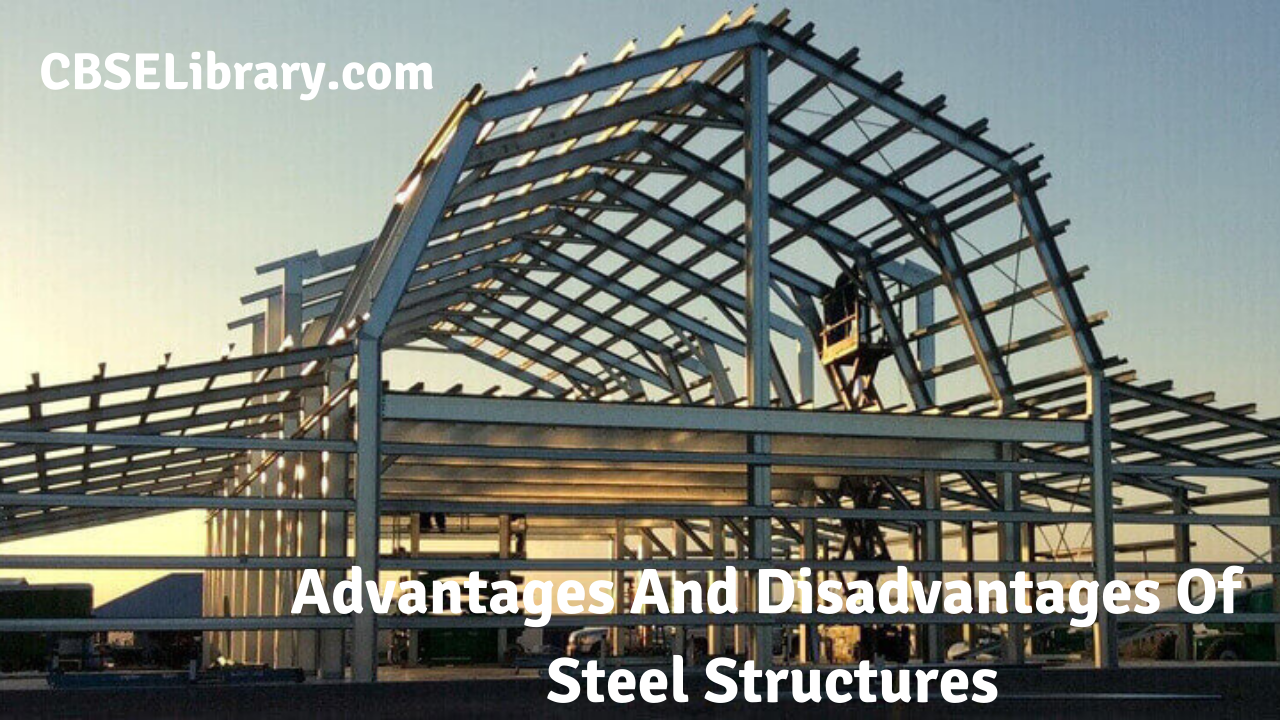Advantages And Disadvantages Of Steel Structures: Structural steel is a category of steel used for making construction materials in different shapes. Many structural steel shapes take the form of an elongated beam having a profile of a specific cross-section. The structural steel shapes, sizes, chemical composition, mechanical properties such as strengths, storage practices, etc., will be regulated by standards in most industrialized countries.
Students can also find more Advantages and Disadvantages articles on events, persons, sports, technology, and many more.
What is a Steel Structure? Advantages and Disadvantages of Steel structure
Structural steel is one of the materials used in steel construction. Structural steel comes in different shapes like L-beam, Z shape, HSS shape, L shape (angle), structural channel (C-beam, cross-section), T shaped, rail profile, bar, rod, plate, and an open joist of web steel.
- Advantages of Steel Structure
- Disadvantages of Steel Structure
- Comparison Table for Advantages and Disadvantages of Steel Structure
- FAQ’s on Advantages And Disadvantages Of Steel Structures
Advantages of Steel Structure
- Reliability: Since steel is homogeneous and elastic by nature, it satisfies most of the assumptions involved in the derivation of the analysis and design formulas. And hence the obtained results will be reliable. Steel exhibits linear-elastic behavior in most engineering applications, Hooke’s law holds good for its elastic range.
- Industrial Behavior: Hot Rolled steel sections are manufactured in factories. The members may be cut and prepared for assembly in factories. Joining these components will be carried out at the site by installing rivets or bolts and welding the different components. Sometimes structural parts are also assembled in the factories resulting in great adaptation to prefabrication. In such cases, manual errors will reduce, and the speed of the construction will increase.
- Lesser Construction Time: Because of its industrial nature, the progress of the work is quite fast in making the structures economical. The reduction in labor cost and overhead changes and the benefits obtained from the early use of the building contributes to the economy.
- High Strength And LightWeight Nature: Steel provides high strength per unit weight. Because steel sections are sturdy and lightweight by nature, the dead load becomes lesser. When the whole structure load is less, the underneath members become smaller because of their less weight.
- Possible Reuse: Steel sections can be reused even after a structure is disassembled.
- Scrap Value: Steel has a scrap value even though it is not reusable in its existing or current form.
- Long Span Construction: High-rise buildings, long-span bridges, and tall transmission towers are made up of structural steel. Industrial buildings can be designed by plate girders or trusses up to a span of 90.m. Bridges are made with plate girders up to a span of 260.m
Disadvantages of Steel Structure
- High Maintenance Costs and More Corrosion: Steels are susceptible to corrosion when freely exposed to air and water and hence must be painted periodically. It leads to extra costs and special care. If not maintained with proper care, steel members can lose 1 to 1.5 mm of their thickness each year, and such constructions can lose weight up to 35% during their specified life and can fail under external loads.
- Fireproofing costs: Even though steel members are incombustible, their strength will drastically reduce at temperatures prevailing in fires. Creep is defined as plastic deformation under a constant load for a more period, and this Creep becomes much more pronounced at about 400ºC. Steel is an excellent conductor of heat and may transmit enough heat from a burning compartment of a building and could extend to other parts of the building. So it costs more to fireproof the building.
- Higher Initial Cost / Less Availability: Steel is not available in abundance in a few countries. The initial cost is also high compared to the other structural materials. This significant factor has resulted in the decline of steel structures in these countries.
- Aesthetics: A 90% majority of residential or office buildings, steel structures without the usage of false ceilings and cladding are considered to have a poor aesthetic appearance. More cost is spent on such a structure to improve their appearance.

Comparison Table for Advantages and Disadvantages of Steel Structure
| Strength is very high- Steels that yield levels higher than 80 ksi (550 MPa) are considered advanced high strength steels. | Fatigue and brittle fracture- Fatigue is an important phenomenon that accounts for 80% of structural failures. |
| Elasticity and uniformity of material – It is a homogeneous and elastic material in nature. Therefore desired results will be obtained. | High maintenance cost – Since it must be painted to make it corrosion-resistant. |
| Speed of the erection and ease of fabrication- The structural fabrication of steel refers to the cutting, bending, and assembling of steel to create different products. | Loss of strength at elevated temperature – Steel has a high expansion rate with changing temperatures. |
| Excellent Ductility and seismic resistance – It allows the structures to bend and deform themselves, to some extent, even without rupturing. | Susceptibility to corrosion and buckling The chances of buckling increase with the length of the steel column. Also, since steel is an alloy of iron, it is more prone to corrosion. |
FAQs on Advantages And Disadvantages Of Steel Structures
Question 1.
What are the different uses of steel Structures?
Answer:
Structural steel is used widely to construct residential and commercial buildings, warehouses, aircraft hangers, hospital and school buildings, metro stations, stadiums, bridges, etc.
Question 2.
What are the differences between steel and concrete structures?
Answer:
Structural steel is one of the leading materials used in commercial and industrial building construction since steel is quite strong, stiff, rigid, and adaptable. Concrete lacks tensile strength, and hence it must be reinforced along with steel bar to increase a structure’s capacity, ductility, and elasticity.
Question 3.
Which is more expensive, steel structure or concrete?
Answer:
The cost of the steel fluctuates depending on the market conditions and the economy whereas the price of the concrete remains constant. But steel is cheaper than reinforced concrete.
Question 4.
Is steel more durable than concrete?
Answer:
In comparison to concrete, steel is dimensionally more durable. Because it does not warp, split, shrink or crack when exposed to the elements. The concrete structure is brittle and hence has less earthquake resistance.
Question 5.
What is the most common type of structural steel?
Answer:
ASTM A36 Steel is the most common material used for structural steel with yield strength of 36,000 psi.
